Japan
Wood Products Prices
Dollar Exchange Rates of 25th
Jun
2023
Japan Yen 143.73
Reports From Japan
Business investment and private
consumption "picking up”
The Japanese government has retained its view that the economy is
recovering moderately. In its Monthly Economic Report the government raised
its assessment of employment conditions for the first time in 11 months
saying there has been "improvement recently". The Cabinet Office retained
its basic assessment of the economy overall as "recovering at a moderate
pace" a month after the government upgraded it for the first time in 10
months in May. The June report described both business investment and
private consumption as "picking up”.
See:https://mainichi.jp/english/articles/20230622/p2g/00m/0bu/050000c
Electricity prices set to rise by over 15%
Households in Japan are suffering following 12 months of
across-the-board price increases for food and other necessities. Now, in
June, electricity bills are set to jump and further price increases for
necessities are expected in the coming months. This upward trend is expected
to continue through to the end of the year further straining household
finances.
Electricity prices are set to rise by over 15% and studies have shown when
the cost of power rises there is a decline in overall household consumption.
One major issue is that wage increases have not kept pace with price rises.
Nominal wages, which measure average pay, increased by only 1.9% in 2022
according to a Health, Labor and Welfare Ministry’s 2022 labour survey.
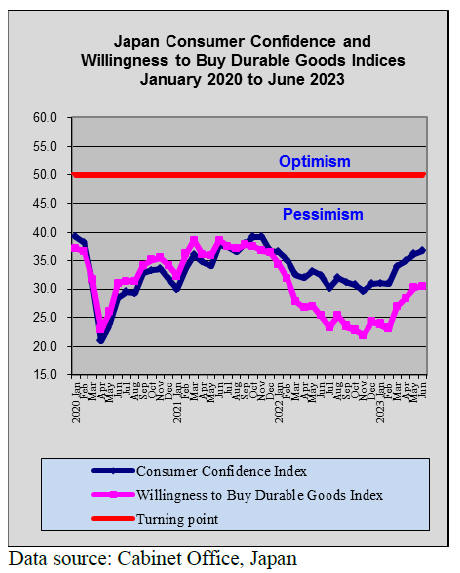
Pollen allergy dents national consumption
As a result of pollen allergy it has been estimated by a research
institute that during the 2023 pollen season consumer spending was reduced
by yen 380 billion (around US$2.5 billion). Very high levels of Japanese
cedar pollen can be found in the air from February through to April. During
this period the number of people suffering an allergic reaction increases
drastically.
The Japanese government aims to cut the pollen count in half over 30 years
vowing to accelerate work to fell and replace cedar trees, the main source
of pollen known to cause allergies for millions of people in Japan.
Speculation on market intervention to boost yen
The US dollar briefly rose above yen 144 in late June, coming
closer to the yen 145 mark when Japanese authorities conducted their first
yen-buying, dollar selling market intervention in 24 years last September.
Speculation on possible market intervention by the Japanese government and
the Bank of Japan is growing.
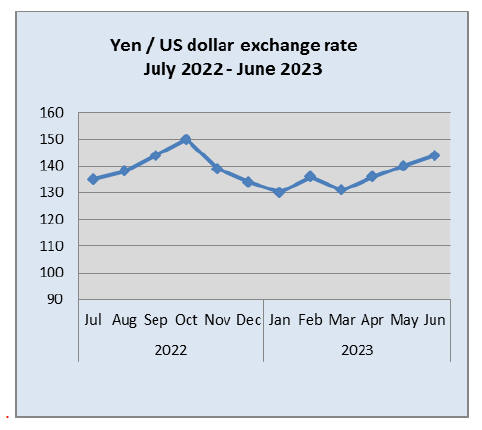
Investment in hotels booming
The booming tourism sector in Japan is attracting investment from
foreign buyers looking for real estate opportunities. The hotel segment
received nearly yen 98 billion (US$690 million) in overseas investment
between January and mid-June this year, more than five times the yen 17.8
billion in the first half of 2022, according to data from research firm MSCI
Real Assets.
The other real estate segments in Japan attracting overseas investment are
offices and multifamily properties according to market observers. In the
period January to April the office segment saw yen 44.1 billion in foreign
investment, while the multifamily segment attracted yen 99.6 billion
according to MSCI Real Assets.
See:https://www.msci.com/our-solutions/indexes/real-estate-indexes
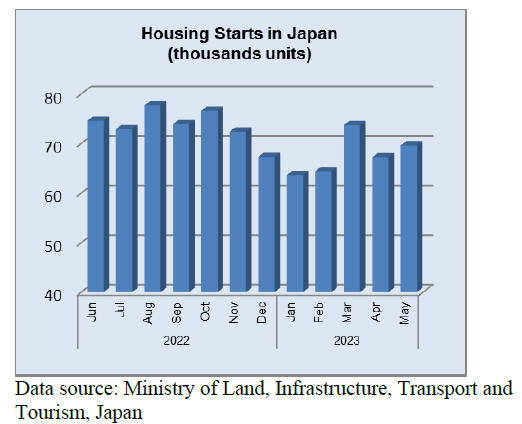
A press release from Research and Markets introduces
the updated "Japan Construction Industry Databook Series - Market Size and
Forecast by Value and Volume, Q1 2023 Update" report.
The report says the construction industry in Japan is expected to grow by
4.6% to reach yen 35,516 billion in 2023. Despite near-term challenges in
certain construction sectors, medium to long term growth story in Japan
remains intact.
The growth momentum is expected to continue over the forecast period,
recording a CAGR of 3.8% during 2023-2027. The construction output in the
country is expected to reach yen 41,240.9 billion by 2027.
See: researchandmarkets.com/reports/4747859/japan-construction-industry-databook-series?utm_source=CI&utm_medium=PressRelease&utm_code=wgz5zw&utm_campaign=1821982+-+Japan+Construction+Industry+Report+2023%3a+Output+is+Expected+to+Reach+JPY+41%2c240.9+Billion+by+2027+from+JPY+35%2c516+billion+in+2023&utm_exec=chdo54prd
Salvage timber business
The problem of abandoned homes is becoming more serious across
Japan but one enterprise has seen this issue as an opportunity.
A company in western Japan's Chugoku Region is demolishing old traditional
homes to recover valuable timber.
The company pays the home owner a portion of the demolition cost and
recovers timber which can be sold on for processing into furniture and
modern interior items giving a second life to old timbers.
See:
https://mainichi.jp/english/articles/20230623/p2g/00m/0na/057000c
Import update
Since the third quarter of 2022 the monthly value of furniture
imports has become less predictable. For each of the three of the furniture
categories tracked, wooden office, kitchen and bedroom furniture, monthly
import values have swung widely, a feature not seen before in Japanese
furniture imports. This is likely a reflection of changes in the Japanese
economy where rising inflation and the weak yen is pushing up import costs
which are being passed on to consumers.
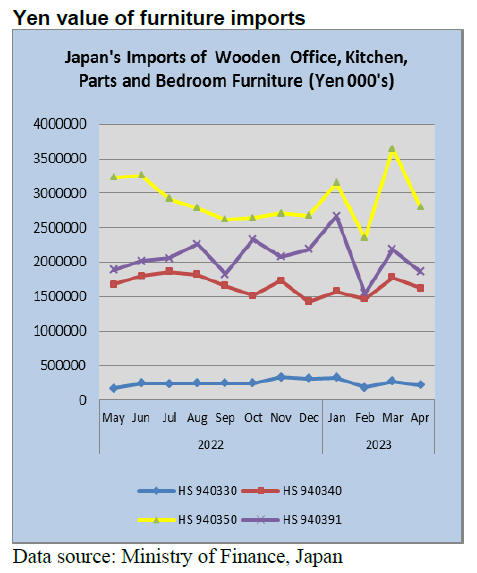
April wooden office furniture imports (HS
940330)
Year on year the value of wooden office furniture imports in April
were little changed from 2022 but there was a slight (2%) decline in the
value of imports compared to levels reported for March.
March shipments of wooden office furniture from China to Japan accounted for
around 75% of April imports. The other main suppliers were Poland (7% of
April arrivals) and Italy (2%).
April shipments of wooden office furniture from China were again lower (31%)
than in March which extended the downturn in the value of imports of this
product from China.
In contrast April arrivals from Vietnam, while
small, more
than doubled in April. Exporters in Malaysia and
Indonesia maintained the level of exports in April at
around the same value as in the previous month.
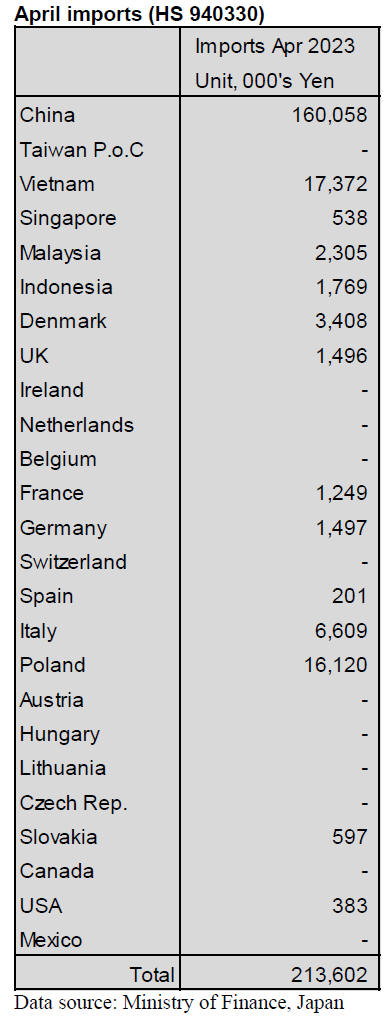
April kitchen furniture imports (HS 940340)
The Philippines and Vietnam continued as the main
suppliers of wooden kitchen furniture (HS 940340) to
Japan in April but both recorded declines in the value of
exports with the Philippines logging a 20% decline month
on month and Vietnam a 10% decline.
Year on year the value of Japan’s April wooden kitchen
furniture imports were flat but there was a 9% decline in
the value of imports compared to March.
In April the Philippines supplied 39% of all wooden
kitchen furniture to Japan followed by Vietnam (37%),
Italy (8%) and China (4%).
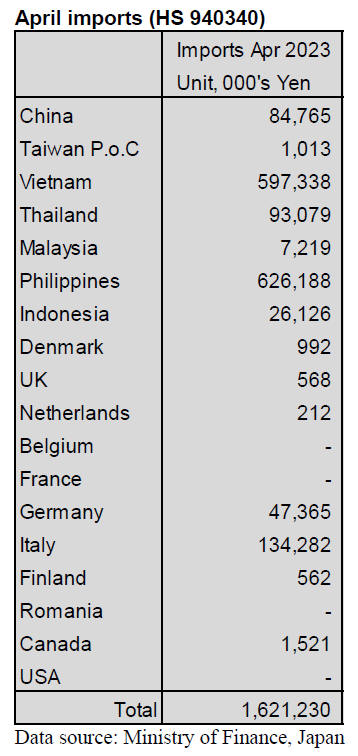
April wooden bedroom furniture imports (HS
940350)
The value of Japan’s imports of wooden bedroom
furniture has oscillated from dips to highs in recent
months, a sharp contrast to the steady upward trend seen
over the past 12 months.
The sharp upward correction in the value of shipments of
wooden bedroom furniture in March was reversed in
April. The top supplier, China, saw an 18% drop in the
value of April shipments to Japan and there was an over
30% decline in the value of shipments from Vietnam. The
other significant shippers, Malaysia and Indonesia both
saw a decline in the value of April shipments.
Recent statistics on investment in the real estate sector
goes some way to explain the steady upswing in the value
of Japan’ wooden bedroom furniture imports.
The post pandemic booming tourism sector has attracting
investment by foreign buyers looking for real estate
opportunities. In particular the hotel segment received
nearly US$700 million in overseas investment between
January and mid-June this year, more than five times that
in the first half of 2022 and hotel refurbishment has most
likely been a driver of demand for beds.
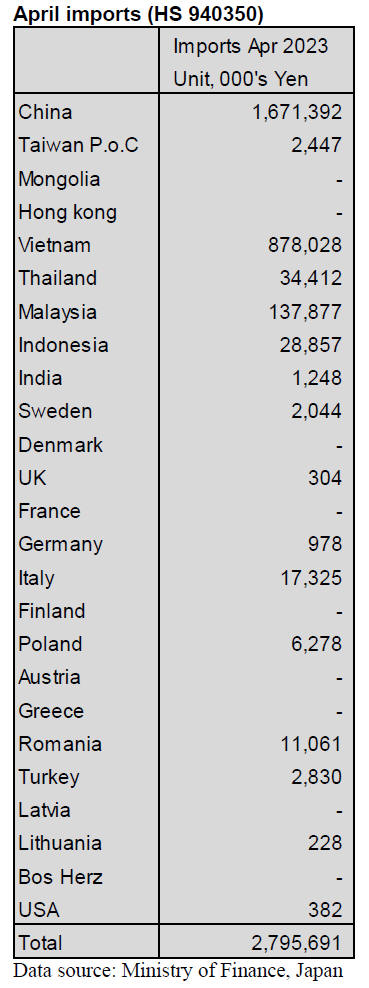
April wooden furniture parts imports (HS
940391)
The value of Japan’s imports of wooden furniture parts in
April was around 15% below that in March but remained
little changed from the value of April 2022 imports. The
top shippers in April were China (44% of the total),
Indonesia (19%), Vietnam (14%) and Malaysia (11%).
In April shipments from the top supplier, China, were
down over 20%, shippers in Vietnam saw an increase in
parts shipments while shippers in Thailand and Malaysia
saw April shipments come in below that in March.

Trade news from the Japan Lumber Reports (JLR)The
Japan Lumber Reports (JLR), a subscription trade journal
published every two weeks in English, is generously
allowing the ITTO Tropical Timber Market Report to
reproduce news on the Japanese market precisely as it
appears in the JLR.
For the JLR report please see:
https://jfpj.jp/japan_lumber_reports/
Closing account of 4 major building
materials trading companies
The four major building materials trading companies in Japan, which
are Itochu Kenzai Corporation, SMB Kenzai Co., Ltd., Sojitz Building
Materials Corporation and Toyo Materia Corporation, hit the best sales ever
in the 2023 fiscal year.
However, three companies of the four companies have a drop in profits
because the prices of domestic / imported lumber and laminated lumber, which
were skyrocketed by the wood shock in April, 2021, plunged in earlier 2023
and imported plywood caused a bad result at the second half of 2023.
However, the profits are still high levels even though there are drops in
profits because the profits of the 2022 fiscal year were extremely high.
The new starts are stabilized from the preceding term but the price of
imported lumber began to fall because the inventory adjustment is not good.
Some of imported lumber are sold at half price.
The price of domestic plywood reached the highest price in June, 2022 due to
a decrease in inventory and there was the wood shock in March, 2022 and in
March, 2023. During the wood shock in those periods, the movement of lumber
was not good due to low demand of houses and also the prices of anything
related to energy and petrifaction-based materials soared due to the
invasion in Ukraine by Russia. Therefore, the building material companies
raised the selling price at the market for the whole time.
Nisshin’s new berth
Nisshin Co., Ltd. in Tottori Prefecture completed construction of a
landing place for non-international coastal trading vessels next to the
plant. The landing space is located in the west side of the head factory. It
is a private berth for the company.
A small vessel carries about 1,300 cbms of domestic cedar logs and domestic
larch logs to the Nisshin’s private berth. The company plans to accept five
vessels in a month. The company used to unload logs at an outer harbor of
Sakai port, which is a public port in Tottori Prefecture. However, there has
been a problem of confusion at the landing place and many demurrages because
volume of wooden pellets and PKS from overseas has been increasing for
wooden biomass power generation plants in recent years. It took three years
for planning and it took a year and a half for completion of the berth.
The fire occurred at Nisshin’s plant in June, 2022 and the company could not
produce much long-sized lumber. On 22nd May, the company restarted producing
long-sized lumber for the first time in eleven months. By unloading logs at
the private berth, it will reduce transportation costs.
Shinakimoku restarted producing plywood
Shinakimoku’s plywood plant in Akita Prefecture restarted an
operation in April, 2023. The plant had been stopped producing plywood due
to the fire in October, 2022.
The plant used to produce 14,000 – 15,000 cbms of plywood but the plant
produced 2,000 cbms of plywood in May. The company will expand product
gradually. There are three product lines at the plant and one of the product
lines was not damaged badly so it was able to fix the product line soon.
Mr. Sasaki, the president of the company, says that the company fixed the
product line quickly to keep employees motivated because producing plywood
is the fundamental job of the company. It is difficult to ask the employees
to come back to the company once the employees leave the company so the
president promised to the employees that the company will repair the plant
definitely to ease anxiety and to avoid job separations.
The president says that he did not know what to do for restart an operation
at first but he could start repairing with a lot of help from people who are
involved with the company in the beginning of this year. Fortunately, the
company had ordered new machines before the fire and the company could
restart producing plywood on 17th April, 2023. The company sent plywood to
the market on 27 th, April. Now, the plant produces only 24mm 3 x 6 plywood.
The company will expand the product in June but the company will arrange
with clients about volume of plywood because of low demand of plywood
recently.
South Sea logs and lumber
There are not enough South Sea logs in South Asia and there would
be a delay of supplying South Sea lumber to Japan. Some Japanese trading
companies try to purchase the South Sea lumber even though demand of South
Sea lumber in Japan is low. ‘It is pre-consumption of future demand’, a
trading company says.
The price of laminated fixture lumber is unchanged from the previous month
but there are not many inquiries for laminated fixture lumber because the
yen kept falling to 140 yen against the dollar.
Chinese sellers and Indonesian sellers are unable to lower the price because
the price of raw materials is high. Additionally, there won’t be a lot of
orders from Japanese buyers even if Chinese seller or Indonesian sellers
lowered the price. Japanese buyers purchase current needs only.
Volume of imported laminated structural lumber
Volume of imported laminated structural lumber has been around
40,000 cbms in almost every month since November, 2022. This is a very
low-level volume. In April, 2023, the volume imported laminated structural
lumber is 37,305 cbms and this is for the first time thirteen years to be
under 40,000 cbms. One of reasons for a decrease in volume is that there was
a strike at ports for two weeks in Finland. Lumber from Finland to Japan
occupies 40% of total imported lumber volume. A lot of imported laminated
structural lumber kept arriving to Japan until September, 2022 and it became
an excess supply due to overstocking.
Contracts during the 3Q of 2022 to the 2Q of 2023
have been small and there will be less imported laminated structural lumber
until September, 2023.
A special feature on pollen allergy
The Japanese Governmen trecently met to discuss the ailment
affecting the whole nation, which is Japanese cedar pollinosis, on 30th,
May.
Artificial cedar forests will be removed by 20% in ten years and volume of
cedar pollen will be half in thirty years. It is good news for people who
suffer with the cedar pollen every year but there is a concern that if many
cedar trees were cut down, it would affect demand and supply of cedar
lumber.
Measures to combat hay fever are a source measure, a pollen flying measure
and the appearance of pollinosis measure. Cedar trees store pollen as the
cedar trees grow and spread the cedar pollen. Over twenty years old cedar
trees have a lot of cedar pollen.
In Japan, there are 4,440,000 hectares of artificial cedar forests and
4,310,000 hectares of artificial cedar forests are the source to spread the
cedar pollen. To reduce the cedar pollen, 50,000 hectares of the cedar trees
will be cut down in a year. 70,000 hectares of the cedar trees will be cut
down annually in ten years.
Nursery trees or other kind of trees, which have less pollen, will be
planted instead of cedar trees. Product of young cedar trees is 28,400,000
trees in 2021 and product of other young trees, which have less pollen, is
15,120,000 trees, 53.2% less than young cedar trees.
The Japanese Government will promote on using more cedar logs for lumber
because there will be many cedar logs cut down. Demand of cedar lumber will
be 17,100,000 cbms in ten years from 12,400,000 cbms in 2023. There will be
a problem of a labor shortage in the future so many high efficiency machines
for forestry will be in introduced. To prevent spreading cedar pollens,
there will be inhibitor for cedar pollen in five years.
|